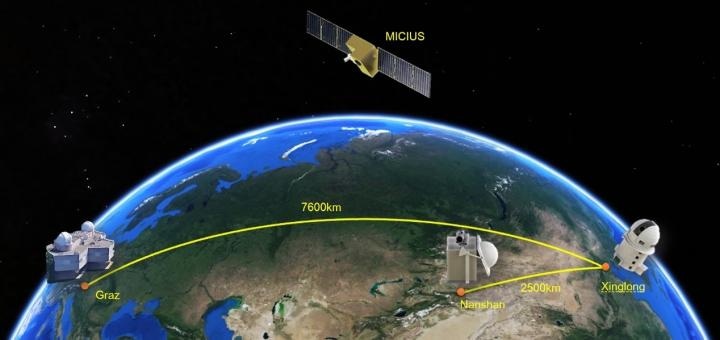Jan 23 2018
One fundamental human need is private and secure communication. Considering the exponential growth of e-commerce and Internet use, it is very important to ensure that a secure network with global protection of data is established.
Customary public key cryptography often depends on the computational intractability of specific mathematical functions. On the contrary, quantum key distribution (QKD) employs individual light quanta (single photons) in quantum superposition states, to ensure unconditional security between distant parties.
 Illustration of the three cooperating ground stations (Graz, Nanshan, and Xinglong). Listed are all paths used for key generation and the corresponding final key length (Image credit: University of Science and Technology of China)
Illustration of the three cooperating ground stations (Graz, Nanshan, and Xinglong). Listed are all paths used for key generation and the corresponding final key length (Image credit: University of Science and Technology of China)
Earlier, the terrestrial free space or the optical channel losses of fibers used to limit the quantum communication distance to a few hundred kilometers. One potential solution to this problem manipulates space and satellite-based links, which can easily connect two remote points on the Earth with considerably reduced channel loss. This is because most of the propagation path of photons is in empty space with minimal loss and decoherence.
At the Chinese Academy of Sciences, a cross-disciplinary multi-institutional research team has spent over a decade in designing an advanced satellite called Micius. The team was headed by Professor Jian-Wei Pan. Dedicated to quantum science experiments, the Micius satellite was launched on August 2016 and it orbits at an altitude of approximately 500 km. To cooperate with the Micius satellite, five ground stations are built in China and are located in Nanshan (near Urumqi), Xinglong (near Beijing), Lijiang (26°41'38.15''N, 100°1'45.55''E), Delingha (37°22'44.43''N, 97°43'37.01"E) and Ngari in Tibet (32°19'30.07''N, 80°1'34.18''E).
In less than a year after the satellite launch, three major milestones for a global-scale quantum internet have been accomplished: ground-to-satellite quantum teleportation (Ren et al. 2017, Nature 549, 70), satellite-based entanglement distribution to two locations on the Earth (separated by approximately 1200 km) and the Bell test (Yin et al. 2017, Science 356, 1140), and satellite-to-ground decoy-state QKD with kHz rate over a distance of approximately 200 km (Liao et al. 2017, Nature 549, 43). Within the satellite-based QKD, the effective link efficiencies were measured to be roughly 20 orders of magnitudes larger than direct transmission via optical fibers at the same 1200-km length. The three experiments marked the initial steps towards a universal space-based quantum internet.
Currently, the satellite-based QKD has been integrated with metropolitan quantum networks, wherein fibers are utilized to easily and efficiently connect many number of users within a city over a distance scale of about 100 km. For instance, optical fibers have been used to connect the Xinglong station to the metropolitan multi-node quantum network in Beijing. The largest fiber-based quantum communication backbone was recently built in China, also by Professor Pan's research team, connecting Beijing to Shanghai (going through Jinan, Hefei and 32 trustful relays) with a 2000-km fiber length. Banks, government, securities and insurance companies are testing this backbone for real-world applications.
For high-security key exchange, the Micius satellite can be further manipulated as a reliable relay to easily link any two points on Earth. The Micius satellite is indeed a powerful platform for quantum key distribution with varying ground stations on Earth. To demonstrate this fact, QKD from the Micius satellite to Graz ground station close to Vienna was successfully conducted this June in association with Professor Anton Zeilinger of Austrian Academy of Sciences.
Therefore, the satellite successfully establishes a secure key between itself and a location, and another key between itself and another location. Then, following a request from the ground command stations, the Micius satellite acts as a reliable relay, performing bitwise exclusive OR operations between the two keys and relaying the result to one of the ground stations. As a result, a secret key is established between Europe and China at locations separated by 7600 km on Earth. For an ultra-long-distance global quantum network, this latest study could provide an efficient solution.
Using about 80 kbit secure quantum key, a picture of Schrödinger (with a size of 4.9 kB) was transmitted from Vienna to Beijing and a picture of Micius satellite (with a size of 5.34 kB) was transmitted from Beijing to Vienna for one-time-pad encoding.
In addition, an intercontinental video conference was held between the Austria Academy of Sciences and the Chinese Academy of Sciences, using the Advanced Encryption Standard (AES)-128 protocol that was able to refresh the 128-bit seed keys each second. The video conference lasted for 75 minutes with an overall data transmission of about 2 GB.